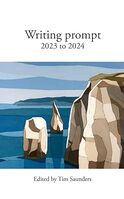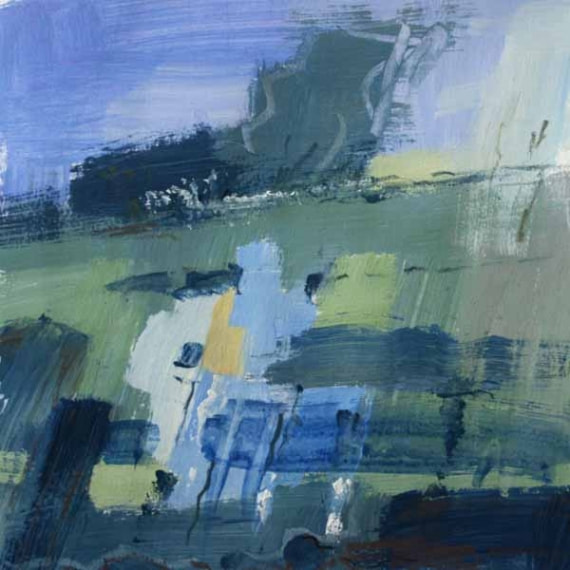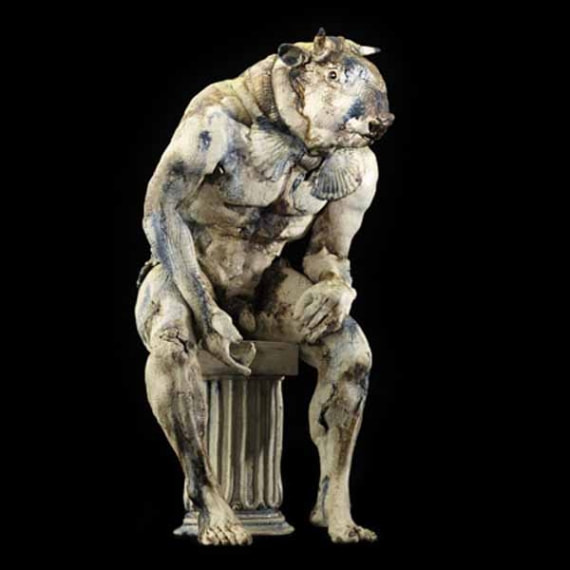
A painting is selected from a professional artist belonging to www.creativecoverage.co.uk.
Contributors are invited to submit a poem up to 30 lines or a story up to 500 words (as a Word .doc file) about the painting. The submissions are initially published on this website and then in a book. Please email submissions (with the date of the prompt in the subject bar) to [email protected] Launched in 2022, the first year's challenge is now available as a book: A year of writing prompts. Read it to get a good idea of how to tackle this. |
April 19, 2024
Shifting shapes, Peak District, acrylic, 12" x 12" by Brian Steventon RBSA
www.creativecoverage.co.uk
www.creativecoverage.co.uk
March 18, 2024
Inside Cnossian
Crazed bull paws and scrapes the dusty ground,
he bellows out the most hideous roaring sound!
Lowers his piercing horns, cries out in hunger,
yearns for youthful flesh, awakens from his slumber.
White albino fur but still a vile, ferocious creature,
breath to melt all flesh, rippling torso, is his feature.
Trapped inside this hell, she tries to evade her ordeal,
tight stomach, heart beat thumps, she tries not to squeal.
He advances, eyes of pink blood and black onyx roll,
gored, her limp body falls, he takes her heart and soul.
Laura Sanders
Minotaur
With the head of a bull, the body of a strong man,
sacrificed to this, you would run as fast as you can!
Inside a dark, dark labyrinth, a long winding maze,
the minotaur snorts and stomps, enjoying his day.
Many youths, he has consumed, in his evil quest,
putting skills and ideas of the young, to the utmost test.
It seems he liked too much the taste, for human flesh,
and sacrificial blood offering, which he enjoyed the best!
No docile bull, sedately munching green, lush grass,
he violently charges, not letting anyone pass!
Trapped in the maze, and unable to navigate out,
he will gore you, toss you, no-one will hear you shout!
Seems hero Theseus, won him with a ball of string game,
he unwound it, so he could return, same way that he came!
With help of lover Ariadne, and his sword, on island of Crete,
the Minotaur in Greek mythology, was stabbed and thus beat!
Laura Sanders
A gentler side
Hi my name is Mino,
I want to tell you a story.
But before I do I must let you know,
you might find it a little gory.
I am half bull, half human,
I have a particular vice.
My favourite food is people,
I’m fed young men as a sacrifice.
I am very strong, live in a maze,
everyone’s scared of me.
But that makes me sad simply because,
that’s not how I want it to be.
I have a much gentler side,
that I cannot really display.
If I try to be friendly to people,
they simply run away.
Wasn’t it obvious that by crossing human and bull,
they would create something most unappealing?
Did they expect it to sit quietly in a corner,
and just stare up at the ceiling?
I want to know what love feels like,
experience feelings and emotion.
Come spend some time with me,
teach me all about devotion.
Don’t worry you’ll be quite safe,
you can trust me, have no fear.
But just in case I get peckish,
perhaps you shouldn’t sit too near!
Garry Davidson
Crazed bull paws and scrapes the dusty ground,
he bellows out the most hideous roaring sound!
Lowers his piercing horns, cries out in hunger,
yearns for youthful flesh, awakens from his slumber.
White albino fur but still a vile, ferocious creature,
breath to melt all flesh, rippling torso, is his feature.
Trapped inside this hell, she tries to evade her ordeal,
tight stomach, heart beat thumps, she tries not to squeal.
He advances, eyes of pink blood and black onyx roll,
gored, her limp body falls, he takes her heart and soul.
Laura Sanders
Minotaur
With the head of a bull, the body of a strong man,
sacrificed to this, you would run as fast as you can!
Inside a dark, dark labyrinth, a long winding maze,
the minotaur snorts and stomps, enjoying his day.
Many youths, he has consumed, in his evil quest,
putting skills and ideas of the young, to the utmost test.
It seems he liked too much the taste, for human flesh,
and sacrificial blood offering, which he enjoyed the best!
No docile bull, sedately munching green, lush grass,
he violently charges, not letting anyone pass!
Trapped in the maze, and unable to navigate out,
he will gore you, toss you, no-one will hear you shout!
Seems hero Theseus, won him with a ball of string game,
he unwound it, so he could return, same way that he came!
With help of lover Ariadne, and his sword, on island of Crete,
the Minotaur in Greek mythology, was stabbed and thus beat!
Laura Sanders
A gentler side
Hi my name is Mino,
I want to tell you a story.
But before I do I must let you know,
you might find it a little gory.
I am half bull, half human,
I have a particular vice.
My favourite food is people,
I’m fed young men as a sacrifice.
I am very strong, live in a maze,
everyone’s scared of me.
But that makes me sad simply because,
that’s not how I want it to be.
I have a much gentler side,
that I cannot really display.
If I try to be friendly to people,
they simply run away.
Wasn’t it obvious that by crossing human and bull,
they would create something most unappealing?
Did they expect it to sit quietly in a corner,
and just stare up at the ceiling?
I want to know what love feels like,
experience feelings and emotion.
Come spend some time with me,
teach me all about devotion.
Don’t worry you’ll be quite safe,
you can trust me, have no fear.
But just in case I get peckish,
perhaps you shouldn’t sit too near!
Garry Davidson




